Neoregelia: home care
Neoregelia belongs to the rare representatives of indoor flora, although it is notable for its simple cultivation, as well as large decorative leaves that can change color during flowering. The article will consider a detailed description of a unique flower, its main types, features of plant care and methods of reproduction.
Botanical description of the plant
Neoregelia belongs to the small genus of perennial rosette herbaceous plants that lack a stem, and decorativeness is achieved thanks to large beautiful leaves.
Did you know? The plant got its name in honor of the famous botanist Eduard Regel: in Latin, “neoregelia” means “New Regelia”. The plant is widespread in the tropical part of South America: about 60 species of neoregelia live there, which amaze with their individuality - color, shape, size.
Neoregelia has long fleshy roots that can be fixed on trees or the surface of the soil. The plant has a completely absent stem, and the leaves are located one above the other. The height of neoregelia does not exceed 20 cm and resembles the top of palm trees with strap-shaped leaves pointed to the end. The leaves are directed in different directions, so the plant is quite voluminous, reaching a diameter of 80 cm. The length of each leaf can vary from 10 to 40 cm, width - from 2 to 5 cm, depending on the species and age.














The color of the leaves of neoregelia is dark green, but during flowering, the upper leaf plates adjacent to the inflorescence change color, acquiring a purple, pink or orange color.
The flowering of neoregelia is characterized by the appearance in the center of the plant of a short but thick inflorescence, in which numerous axillary flowers develop, tightly pressing against each other. Depending on the type, the color of the flowers can be different - white, purple, lilac, blue.
| Root system | Well developed |
| Stem | Absent |
| Leaf shape | Belt-shaped |
| Leaf color | Dark green |
| Flower shape | Racemose |
| Flower color | Purple, Lilac, White, Blue |
| Fruit shape | Round dry small berries |
| Fruit color | Brown gray |
| Fruit flavor | Not eatable |
The main types
Consider the most common types of neoregelia:
- Carolina neoregelia - in the wild, distributed in Brazil, characterized by long (up to 60 cm) light green leaves that have a brilliant coating. The leaves are collected in groups of 20 pieces and resemble a funnel. Before the plant blooms, the central leaves turn red. Inflorescences are blue, with white-green bracts.

- Neoregelia marble - grows near the ocean, on rocky areas. It has long and sharp scaly leaves, the edges of which are covered with teeth and small spots. The length of the leaves can reach 60 cm, height - 8 cm. The marbled appearance blooms with pinkish-white flowers, which are located in the center of the rosette of leaves.

- Gloomy neoregelia - has a tongue-like shape of leaves, leaf plates are collected in tight rosettes in the shape of a funnel, in the center of which multi-flowered inflorescences of blue color with dark red bracts appear.

- Tiger neoregelia - has lingual leaves that are fairly densely pressed against each other at the base and straightened to the top. The color of the sheet plates is yellow-green, the main feature is the presence of many horizontal stripes of burgundy color on each sheet. The length of the leaves does not exceed 20 cm, the width is 2 cm. Due to the leaves densely arranged to each other, the center of the rosette is quite narrow, so flowering is poorly visible. The plant blooms profusely, in the center of the outlet there are many inflorescences of purple color.
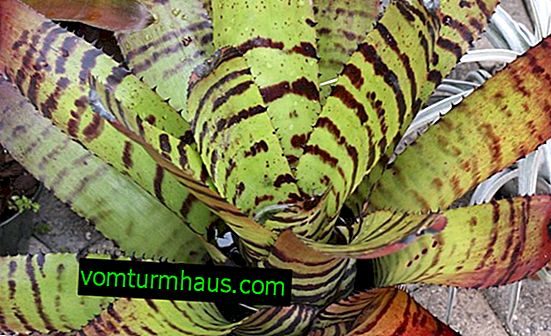
- Beautiful (elegant) neoregelia - has a spreading rosette of leaves. The length of the sheet plates is 40 cm, the width is 4 cm. The tip of each sheet is painted a bright crimson color. In the center of a tight outlet you can see capitate inflorescences of blue flowers.
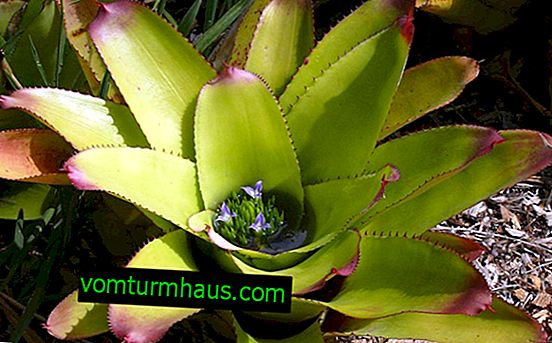
House growing conditions
In order for neoregelia to retain its decorative appearance when grown at home, it needs to provide favorable environmental conditions.
Lighting and ventilation
In the wild, the flower grows in marshy and shady areas of rainforests, so it tolerates cultivation in the shade. Bright lighting also does not hurt - provided that there is no direct sunlight that causes severe burns on the leaf plates. You can place the pot on the west, east shaded or on the north windows. You can also place the plant on the south window with mandatory shading throughout the day.
Important! At home, neoregelia blooms at the end of winter, so maintaining the optimum temperature allows you to extend this period.
Stagnant indoor air is one of the causes of the development of most diseases, so regular ventilation is mandatory. It will be enough to ventilate the room in which the pot is located, 1 time per day for 1 hour.
Temperature and humidity
Tropical neoregelia tolerates heat well, so it grows well in summer at elevated temperatures - up to + 30 ° С. It is important that the temperature during the day and night is not too different: a difference of 5-6 ° is considered the norm. In winter, it is necessary to ensure that the air temperature in the room does not fall below + 15 ° C, the optimum is considered to be + 18–23 ° C.
Humidity for normal flower development should be 60%. To maintain an optimal level of humidity, you can install a container with wet expanded clay near the pot and regularly spray the flower from the spray bottle.

Home Care
For the normal development of the flower, it is necessary to follow some care recommendations.
Watering
Water the plant regularly, in the morning, with water at room temperature. In summer they pour it directly into a leaf outlet, and in winter - under the root, otherwise neoregelia can rot. In summer, watering should be done daily, in winter - 2-3 times a week. For irrigation use only soft water, it is better to previously defended. Every day, the plant can be sprayed from a spray bottle to maintain the required moisture level.
Did you know? Cultivated 40 types of neoregelia - they are often used to decorate greenhouses and botanical parks around the world.
Top dressing
Feeding neoregelia is necessary from May to September, 1 time per month. For feeding use any complex fertilizers for bromeliads according to the instructions. Typically, fertilizers are recommended to be diluted with water and used to water the plants inside the leaf outlet.
Pruning
Neoregelia is a low plant: leaves grow one after another, so the flower does not require forming pruning. Trimming some leaves to preserve the decorative appearance is necessary only if they are damaged, damaged by diseases and pests, or natural dying occurs over time.

Transfer
It is not recommended to transplant the plant often, as it grows and fills up with the root system of the pot - about 1 time in 4–5 years. Be sure to transplant the flower after purchase to remove the transport soil and replace the small plastic pot with a more stable ceramic.
The first transplant should be carried out after the neoregelia has faded, it is better to carry out subsequent transplants in the early spring in order to be in time to wake up the plant and activate growth. Transplanting soil is bought universal or for decorative flowering plants.

It is also possible to prepare the earth mixture yourself from:
- pine bark (3 parts);
- moss sphagnum (1 part);
- peat (1 part);
- sheet land (1 part);
- turf land (0.5 parts).
Transplant Process:
- 1/3 of the volume of drainage (expanded clay) is poured into the prepared pot.
- A little prepared soil mixture is poured on top to lightly cover the drainage layer.
- A plant is very carefully removed from the old pot, the earthen lump is slightly destroyed so that the root system can be examined.
- If there are dead, damaged or diseased roots, they are removed with sharp scissors or a knife, and the place of the cut is sprinkled with crushed activated carbon.
- The plant is installed in a new pot and a little earthen mixture is added to it so that it fills the voids between the interwoven roots.
- To better penetrate the soil into the voids, the pot is periodically shaken and tapped on the floor.
- When the pot is filled to the top, the soil is watered with warm water.
Breeding
There are two ways to propagate neoregelia, each of which has its own nuances that require more careful consideration.
Child sockets
After flowering neoregelia, you can notice that the side buds begin to develop on the plant - daughter rosettes that can be used for reproduction. When the lateral buds grow a little, which takes an average of 2 months, 4 real leaves and aerial roots appear on them. Separate daughter sockets with a sharp knife, very carefully so as not to touch the aerial roots.

The shoots need to be planted in sheet soil with the addition of sand and chopped pine bark. For planting, small containers are used that are filled with expanded clay and earth mix. The plant is watered with water and covered with a transparent plastic film to create a greenhouse effect. Pots are placed on a well-lit window sill and the temperature in the room is maintained at + 26–28 ° С.
After the processes take root, after 1-2 months they can be accustomed to simplified care, as for adult neoregelia.
Important! Daily remove the package and ventilate the shoot to avoid the appearance of rot.
Seeds
Propagation of neoregelia by seeds is a rather complicated and unpredictable process, so it is not practiced so often. Seeds purchased or collected independently are sown in suitable containers filled with a peat-sand mixture. It is necessary to sow according to the scheme: 1 cm in depth, 7 cm between each seed, 7 cm between rows.
Seeds are laid in grooves made and lightly sprinkled with soil. The container is covered with plastic wrap and put on a well-lit window sill, maintain a temperature of + 25 ° C. After emergence, the film is removed. Regularly spray the soil from the spray bottle with warm water. After 3 months, after the appearance of the first shoots, plants can be transplanted into separate small containers, while using soil, as for adult plants.

Possible growing difficulties
In the process of growing neoregelia, some difficulties may arise associated with the development of diseases or the appearance of pests, so we will further consider how to deal with them.
We recommend that you familiarize yourself with other decorative-flowering indoor plants:
Disease
Fusarium is distinguished from common infectious diseases, which manifests itself in the decay of the leaf growth point and the death of the plant. The main reason for the development is regular waterlogging and cool conditions. Treatment of fusarium does not give results, the flower dies. To avoid the development of the disease, it is recommended to more closely monitor the temperature indicators in the room and follow the recommendations for watering.
Pests
Pests that can settle on neoregelia include:
- bromeliad scale - populates both sides of the leaf and leads to the death of the deciduous part of the plant. To deal with the pest, it is necessary to mechanically remove the scabs using a sponge treated with the “Actellica” insecticidal solution or spray the flower with the same solution according to the instructions;
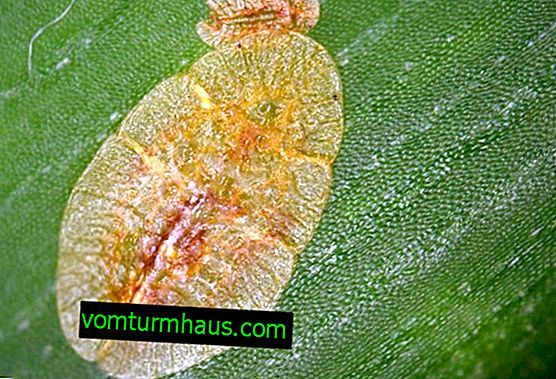
- mealybug - settles on leaves, feeds on their juice, during which it secretes sugary secretions, leading to soot fungus. Signs of infection are slow growth, yellowing of the leaves. To deal with the pest, it is necessary to treat the leaves with soapy water or alcohol. If the defeat is strong and simple remedies do not help, you should resort to the treatment of the leaf part with the Fufanon insecticide;
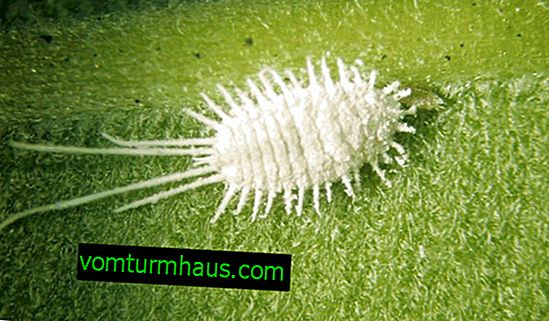
- red spider mite - appears on the back of the leaves. Signs - curl of leaves, the appearance of a thin web. It is necessary to deal with the pest by treating the plant with Decis according to the instructions;
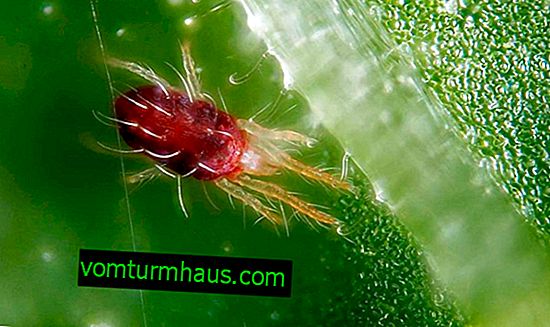
- aphid - populates the front side of the leaf, eats its juice, which leads to yellowing and drying. Fight with aphids follows the drug "Actellik", using it according to the instructions.
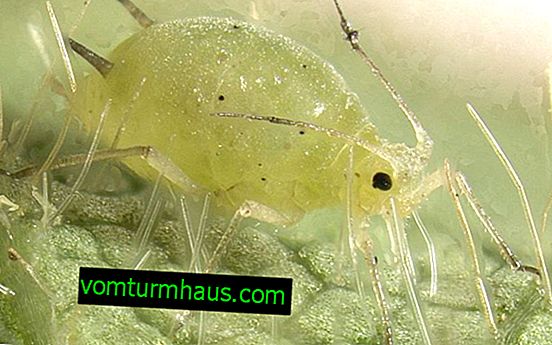
Thus, it is not difficult to grow neorelia in the home, the main thing is to follow the recommendations for care and maintain the necessary conditions in the room for normal growth and flowering.












